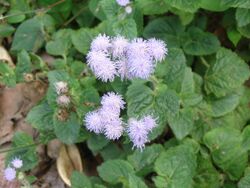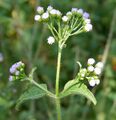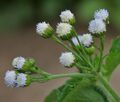Biology:Ageratum conyzoides
| Ageratum conyzoides | |
|---|---|

| |
| Scientific classification | |
| Kingdom: | Plantae |
| Clade: | Tracheophytes |
| Clade: | Angiosperms |
| Clade: | Eudicots |
| Clade: | Asterids |
| Order: | Asterales |
| Family: | Asteraceae |
| Genus: | Ageratum |
| Species: | A. conyzoides
|
| Binomial name | |
| Ageratum conyzoides | |
| Synonyms | |
|
Synonymy
| |
Ageratum conyzoides (billygoat-weed, chick weed, goatweed, whiteweed, mentrasto) is native to Tropical America, especially Brazil , and is an invasive weed in many other regions. It is an herb that is 0.5–1 m. high, with ovate leaves 2–6 cm long, and flowers are white to mauve.[3]
In Vietnamese, the plant is called cứt lợn (meaning "pig feces") due to its growth in dirty areas.[4]
Uses
As a medicinal plant, Ageratum conyzoides is widely used by many traditional cultures, against dysentery and diarrhea.[5] It is also an insecticide and nematicide.[6][5]
Toxicity
Ingesting A. conyzoides can cause liver lesions and tumors.[7][8] There was a mass poisoning incident in Ethiopia as a result of contamination of grain with A. conyzoides.[9] The plant contains the pyrrolizidine alkaloids lycopsamine and echinatine.
Weed risk
A. conyzoides is prone to becoming a rampant environmental weed when grown outside of its natural range. It is an invasive weed in Africa, Australia, Southeast Asia, Hawaii, and the USA.[10][11] It is considered a moderate weed of rice cultivation in Asia.[12]
Gallery
References
- ↑ "NatureServe Explorer". https://explorer.natureserve.org/Taxon/ELEMENT_GLOBAL.2.154971/Ageratum_conyzoides.
- ↑ Tropicos search for Ageratum conyzoides
- ↑ "Ageratum conyzoides". NSW Flora Online. http://plantnet.rbgsyd.nsw.gov.au/cgi-bin/NSWfl.pl?page=nswfl&lvl=sp&name=Ageratum~conyzoides.
- ↑ :vi:Cứt lợn
- ↑ 5.0 5.1 Panda, Sujogya Kumar; Luyten, Walter (2018). "Antiparasitic activity in Asteraceae with special attention to ethnobotanical use by the tribes of Odisha, India". Parasite 25: 10. doi:10.1051/parasite/2018008. ISSN 1776-1042. PMID 29528842.

- ↑ Ming, L.C. (1999). "Ageratum conyzoides: A tropical source of medicinal and agricultural products". in Janick, J.. Perspectives on new crops and new uses. Alexandria VA: ASHS Press. pp. 469–473. ISBN 978-0961502706. http://www.hort.purdue.edu/newcrop/proceedings1999/v4-469.html.
- ↑ Sani, Y.; Bahri, S. (1994). "Pathological changes in liver due to the toxicity of Ageratum conyzoides". Penyakit Hewan 26 (48): 64–70. ISSN 0216-7662. http://agris.fao.org/agris-search/search/display.do?f=1997/ID/ID97008.xml;ID9600846. Retrieved 2013-08-31.
- ↑ Fu, P.P.; Yang, Y.C.; Xia, Q.; Chou, M.C.; Cui, Y.Y.; Lin G. (2002). "Pyrrolizidine alkaloids-tumorigenic components in Chinese herbal medicines and dietary supplements". Journal of Food and Drug Analysis 10 (4): 198–211. http://www.fda.gov.tw/files/publish_periodical/10-4-1.pdf.
- ↑ Wiedenfeld, H. (2011). "Plants containing pyrrolizidine alkaloids: toxicity and problems.". Food Additives & Contaminants: Part A 28 (3): 282–292. doi:10.1080/19440049.2010.541288. PMID 21360374. https://hal.archives-ouvertes.fr/hal-00673672.
- ↑ Global Compendium of Weeds, Ageratum conyzoides (Asteraceae)
- ↑ Alan S. Weakley (April 2008). "Flora of the Carolinas, Virginia, and Georgia, and Surrounding Areas". http://www.herbarium.unc.edu/flora.htm.
- ↑ Caton, B.P. (2004). A Practical Field Guide to Weeds of Rice in Asia. Int. Rice Res. Inst.. pp. 16–17. ISBN 978-971-22-0191-2. https://books.google.com/books?id=ver3qCQF9EEC.
External links
- Plants For Future: Ageratum conyzoides
- Tropical Plant Database: Ageratum conyzoides
- Global Invasive Species Database: Ageratum conyzoides
- (in Portuguese) Ageratum conyzoides photos
- Ageratum conyzoides L. Medicinal Plant Images Database (School of Chinese Medicine, Hong Kong Baptist University) (in Chinese) (in English)
Wikidata ☰ Q1949712 entry
 |








